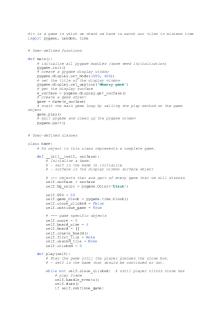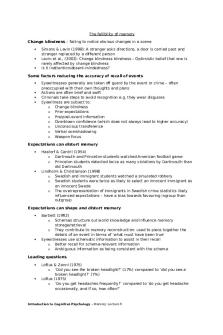Tulving - chapter: the memory PDF

| Title | Tulving - chapter: the memory |
|---|---|
| Author | james gonda |
| Course | General Psychology |
| Institution | Indiana University South Bend |
| Pages | 1 |
| File Size | 40.5 KB |
| File Type | |
| Total Downloads | 70 |
| Total Views | 145 |
Summary
chapter: the memory...
Description
Tulving's SPI model Endel Tulving (1995) has proposed a structural model of memory in which he distinguishes five hierarchically organized memory systems, both in terms of phylogenetic origin and in terms of prominence within the cognitive system. It may be recalled that Sherry and Schacter (1987) defined the term memory system as the "interaction between acquisition, retention and retrieval mechanisms, characterized by certain operating rules (...), with two (or more) systems characterized by fundamentally different rules". From the oldest to the most recent, he considers the following systems, each of them requiring the integrity of the previous systems to function: - Procedural memory: according to this model, it constitutes the oldest and most important memory system; its integrity is necessary for the functioning of the following. Ex: all the techniques of the body - The system of perceptive representation (SRP): it would contain perceptive sketches of the constituent elements of the semantic memory. Ex: the expressions. These first two systems are said to be anoetic since they do not imply any awareness of the "object". - Semantic memory refers to all representations of general knowledge about the world - Primary memory corresponds to the TCM or MDT. This system allows the temporary maintenance and manipulation of information. These two systems are said to be noetic since they involve an awareness of the objects they process - Episodic memory concerns representations of events located in time and space (context). This system is said to be autoenetic because it implies an awareness of the object and of the subject itself as it perceives the object. Ex: schizophrenia and cognitive disorders. The SPI model (for serial, parallel and independent) maintains that: - Encoding is serial, in one system after another, item after item - Storage is parallel, an item can be stored in several systems at the same time - The retrieval is done independently, in the system concerned....
Similar Free PDFs

Tulving - chapter: the memory
- 1 Pages

Chapter 6 Memory
- 3 Pages

Chapter 7 Notes - Memory
- 5 Pages

Chapter 8: Memory Notes
- 5 Pages

Chapter-6-Memory - notes
- 9 Pages

Chapter 5 Memory
- 6 Pages

Chapter 7 Memory Notes
- 8 Pages

Chapter 7 Memory Notes
- 3 Pages

Memory
- 3 Pages

Memory
- 5 Pages

Chapter 3 Learning and Memory
- 20 Pages

Virtual Memory
- 58 Pages
Popular Institutions
- Tinajero National High School - Annex
- Politeknik Caltex Riau
- Yokohama City University
- SGT University
- University of Al-Qadisiyah
- Divine Word College of Vigan
- Techniek College Rotterdam
- Universidade de Santiago
- Universiti Teknologi MARA Cawangan Johor Kampus Pasir Gudang
- Poltekkes Kemenkes Yogyakarta
- Baguio City National High School
- Colegio san marcos
- preparatoria uno
- Centro de Bachillerato Tecnológico Industrial y de Servicios No. 107
- Dalian Maritime University
- Quang Trung Secondary School
- Colegio Tecnológico en Informática
- Corporación Regional de Educación Superior
- Grupo CEDVA
- Dar Al Uloom University
- Centro de Estudios Preuniversitarios de la Universidad Nacional de Ingeniería
- 上智大学
- Aakash International School, Nuna Majara
- San Felipe Neri Catholic School
- Kang Chiao International School - New Taipei City
- Misamis Occidental National High School
- Institución Educativa Escuela Normal Juan Ladrilleros
- Kolehiyo ng Pantukan
- Batanes State College
- Instituto Continental
- Sekolah Menengah Kejuruan Kesehatan Kaltara (Tarakan)
- Colegio de La Inmaculada Concepcion - Cebu



